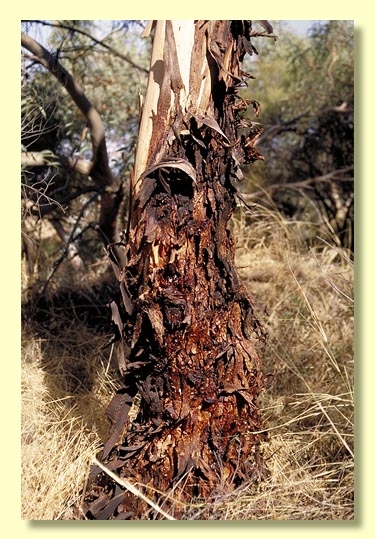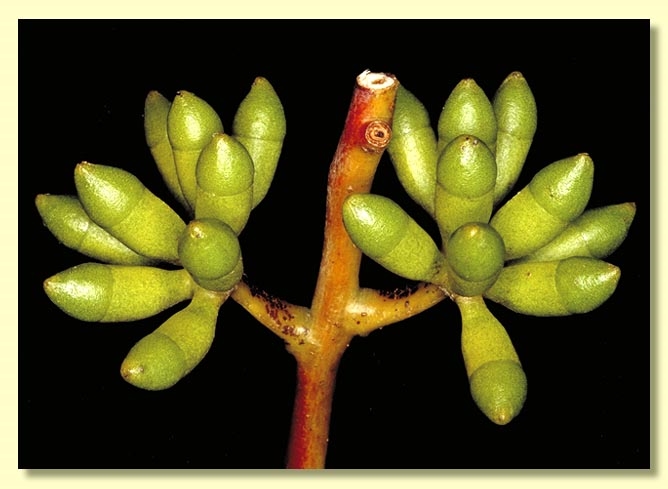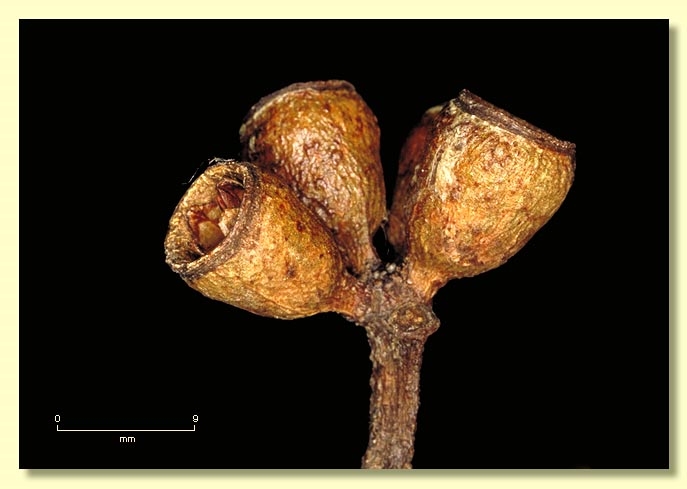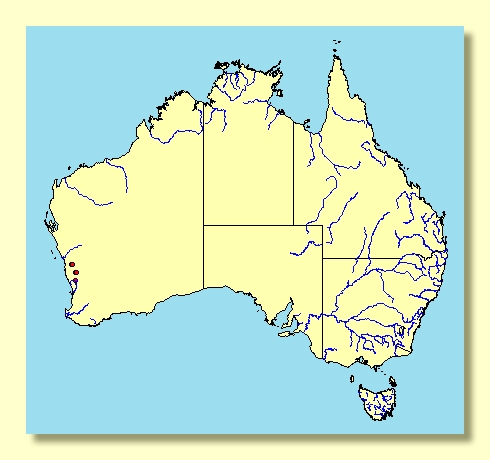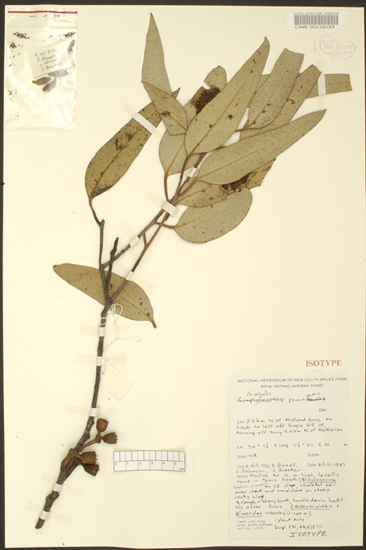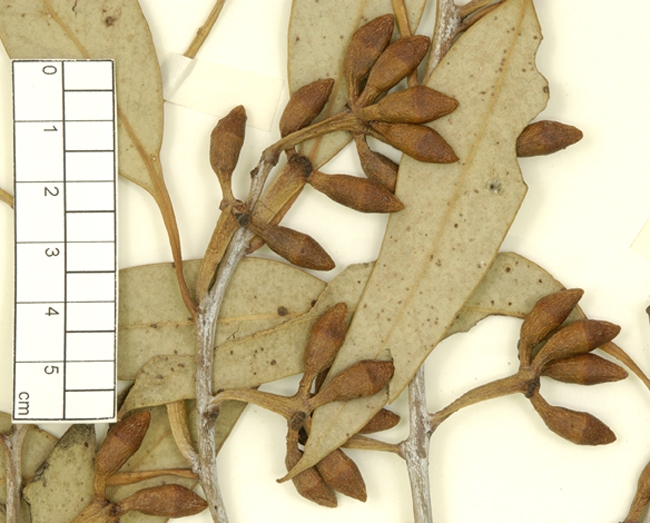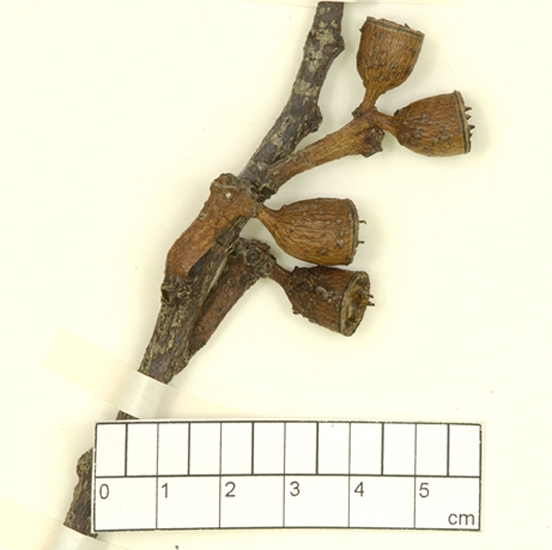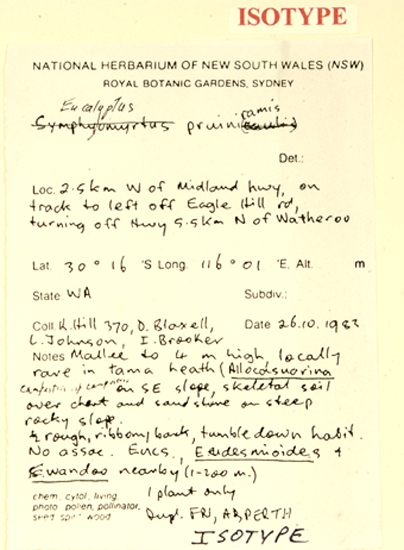Euclid - Online edition
Eucalyptus pruiniramis
Eucalyptus | Symphyomyrtus | Bisectae | Glandulosae | Accedentes
Mallee or tree to 4 m tall. Forming a lignotuber.
Bark rough for lower half of trunk, fibrous or persistent ribbons, dark grey to grey-brown or blackish, or completely smooth on smaller mallees.
Branchlets usually glaucous, occasional plant non-glaucous; oil glands present in the pith but may be sparse.
Juvenile growth (coppice or field seedlings to 50 cm): stems square in cross-section, glaucous; juvenile leaves always petiolate, soon alternate, rounded to broadly ovate or deltoid, 4.5–10.5 cm long, 4–6.5 cm wide, grey-green or glaucous.
Adult leaves thick, alternate, petioles 1.5–3 cm long; blade lanceolate, 8.5–12.5 cm long, 1.5–3.3 cm wide, base tapering to petiole, margin entire, apex pointed, concolorous, dull, green to grey-green, side-veins greater than 45° to midrib, reticulation dense, intramarginal vein remote from margin, oil glands intersectional.
Inflorescence axillary unbranched, peduncles flattened, 0.8–2 cm long, buds 7, 9 or 11, pedicellate (pedicels 0.2–0.5 cm long). Mature buds broadly fusiform to ovoid (1.1–1.6 cm long, 0.5–0.7 cm wide), scar present, operculum conical, stamens inflexed, anthers oblong, versatile, dorsifixed, dehiscing by longitudinal slits, style long and straight, stigma usually blunt, locules 4, the placentae each with 4 vertical rows of ovules. Flowers white.
Fruit normally pedicellate, rarely sessile (pedicels 0–0.5 cm long), cylindrical to cupular, 0.8–1.2 cm long, 0.8–1 cm wide, disc descending obliquely, valves 4, at rim level or exserted.
Seeds grey-brown, 1–2.5 mm long, ovoid to flattened-ovoid, dorsal surface shallowly reticulate, hilum ventral.
Cultivated seedlings (measured at ca node 10): cotyledons Y-shaped (bisected); not grown beyond this stage.
Flowering is in summer (after French (2012)).
A small straggly tree or mallee endemic to Western Australia, found north of Perth from three sites, near Mogumber, Jingymia Hill and surrounds, and between Arrino and Three Springs. The bark is rough for 1–2 m in the trees, but sometimes smooth on the mallee form. The adult leaves are dull, green to grey-green.
Eucalyptus pruiniramis belongs to Eucalyptus subgenus Symphyomyrtus section Bisectae subsection Glandulosae because the cotyledons are bisected, buds have an operculum scar and the branchlets have oil glands in the pith. Within this subsection, E. pruiniramis belongs to a small subgroup of eight species, series Accedentes, further characterised by having buds with inflexed stamens, ovules in four rows and juvenile leaves petiolate. The species are E. accedens, E. laeliae, E. leprophloia, E. trivalva, E. pruiniramis, E. zopherophloia, E. prominens and E. pilbarensis.
E. pruiniramis is distinctive within its natural range because of its glaucous branchlets, dull green to grey-green leaves, ovoid-fusiform buds and occurrence on gravelly soils on slopes and ridges. Of the related species within this general area, E. leprophloia is a loosely rough-barked mallee with glossy green leaves, slightly smaller fruit and is restricted to a loamy valley between breakaways; E. zopherophloia is a mallee with tight fibrous bark, dull to slightly glossy green leaves found on limy coastal soils; whilst E. accedens is a widespread tree with powdery bark, dull blue-green adult leaves and very large juvenile leaves. Further to the north E. prominens occurs on coastal limestone and is mostly smooth-barked, has glossy green leaves and usually larger fruit with exserted valves.
Eucalyptus pruiniramis is listed as "Endangered" under the Australian Government Environment Protection and Biodiversity Conservation Act 1999 (EPBC Act). Further information may be found at this web address:
http://www.environment.gov.au/cgi-bin/sprat/public/sprat.pl


